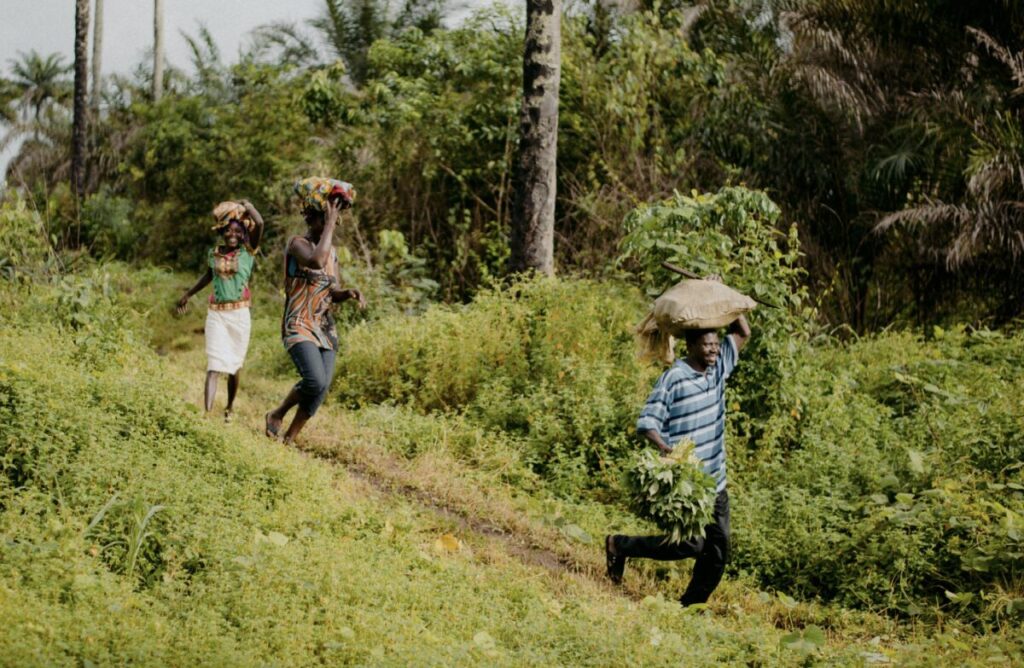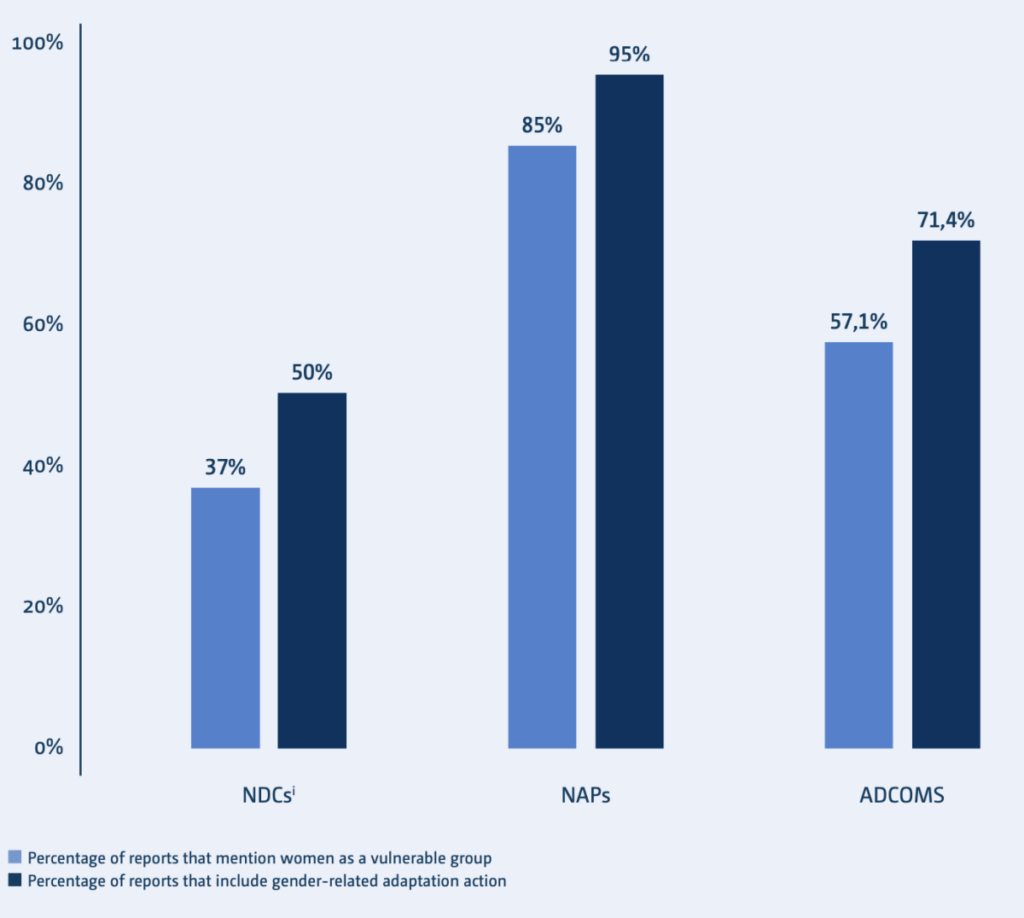Progress, good practices and lessons learned in prioritizing and incorporating gender-responsive adaptation action

Introduction
To address the gender-specific impacts of climate change, and to advance gender equality and women’s empowerment through climate change adaptation plans and policies, countries around the world are increasingly applying gender-responsive approaches. The following assessment of recent trends in adaptation research and action, including the formulation and implementation of NAPs, reveals some gaps and challenges for the application of gender-responsive approaches. It also provides opportunities and good practices that governments and other stakeholders have identified and are undertaking to enhance resilience and gender equality in a comprehensive and synergistic manner.
In this regard, Parties to the Convention have recognized the importance of engaging women and men equally in the UNFCCC process and in the development and implementation of gender-responsive climate strategies. To support Parties in this endeavour, specifically in the area of adaptation, members of the Adaptation Committee’s NAP task force prepared this policy brief on progress, good practices and lessons learned in prioritizing and incorporating gender-responsive adaptation action under the framework of the flexible workplan for 2022–2024.
This policy brief has the objective of helping governments and other stakeholders to develop and implement gender-responsive adaptation action, taking into consideration the different national circumstances and cultural values.
This article is an abridged version of the original text, which can be downloaded from the right-hand column. Please access the original text for more detail, research purposes, full references, or to quote text.
Good practices and lessons learnt
The exacerbated impacts of climate change on women, and gender and sexual minorities can only be addressed by adaptation plans and policies that specifically take them into account. This means using gender-responsive approaches and including women, and gender and sexual minorities in the full scope of the decision-making process and implementation of all adaptation actions. Gender-responsive approaches examine and actively address gender norms, roles and inequalities. They actively seek to promote gender equality.
This section highlights good practices and lessons learnt on challenges and opportunities for gender-responsive adaptation:
- To be effective, gender responsiveness should be taken into account in all stages of the adaptation cycle: the assessment of impacts, vulnerability and risks; planning; the implementation of adaptation measures; and monitoring and evaluation.
- A gender-responsive approach to adaptation planning involves ensuring that there is a balanced gender representation in all decision-making spaces and explicitly including objectives and activities related to enhancing gender equality and women’s empowerment in adaptation plans at all levels.
- Participatory decision-making is key to capturing the experiences and needs of all genders, which translates into more effective climate action.
- Adaptation plans have the highest potential to contribute to gender equality when they address the root causes of differentiated vulnerability and exclusion.
- A gender-responsive approach to the implementation of adaptation action recognizes that women are central actors in the response to climate change, and in many cases are leading the way.
- Gender-responsive monitoring, evaluation and learning is crucial to assessing whether adaptation policies have met their gender equality and women’s empowerment objectives, and whether they have had unintended consequences related to gender, as well as to make the necessary adjustments for the future.
- Ensuring adequate means of implementation and support is crucial to advancing gender-responsive adaptation planning and implementation. Capacity-building, for example through targeted training, and climate finance, including through gender-responsive budgeting, are essential for governments and other implementing organizations to meet their gender-related objectives.

Country example: Guinea-Bissau: In its updated NDC, Guinea-Bissau identified adaptation projects that have developed gender action plans and gender-sensitive budget activities, such as initiatives on strengthening the resilience of vulnerable coastal areas and enhancing climate information and early warning systems. The projects use the UNDP gender marker system for gender budgeting to ensure that sufficient resources are allocated for the projects’ objectives on gender equality and women’s empowerment, and to ensure that this budget allocation is tracked.
Progress made in advancing gender-responsive adaptation
Parties to the Convention and the Paris Agreement have increasingly applied a gender-responsive approach to adaptation planning and implementation, as reflected by their NAPs, NDCs and adaptation communications. According to the latest assessments for 2022, 75% of all NDCs, 97.5% of NAPs and 77.1% of adaptation communications include gender considerations.
Reports integrate gender mainly into two categories: recognizing the specific vulnerabilities that women and gender and sexual minorities face as a consequence of climate change; and including adaptation goals and actions that advance gender equality and women’s empowerment, or at least ensure these are not negatively affected by adaptation policies.

There is a qualitative shift in the integration of gender considerations in NDCs, including in the adaptation sections. An increasing number of Parties characterized women as agents of change in their updated NDCs, instead of portraying them only as a vulnerable group, and recognized gender- responsiveness as an element contributing to the overall ambition and effectiveness of climate action.
A similar trend can be identified regarding gender considerations in NAPs. Most NAPs also provide entry points for a deeper and more consistent integration of gender considerations in future iterations of NAPs, as well as for developing stronger gender-responsive implementation, communication strategies, and monitoring and evaluation frameworks.
Gender responsiveness also features prominently in adaptation communications. Parties have reported mainstreaming gender in their climate change adaptation strategies and institutionalizing gender-responsiveness through laws and regulations, as well as by involving and/or creating gender agencies and focal points.
Gaps and needs
Gaps and needs identified by Parties in NAPs, NDCs and adaptation communications include:
- The lack of sufficient gender- disaggregated data related to the impacts of climate change and vulnerabilities, as well other information and knowledge needed to develop gender-responsive adaptation policies.
- Inequitable representation of women in decision-making spaces relevant to climate change adaptation in all cases or at all levels.
- The lack of an enabling legal and institutional environment to advance gender-responsiveness in adaptation policies, including incentive mechanisms.
- The need for further funding and financial resources allocated to gender-responsive and participatory adaptation planning processes, and to implementing projects.
- The absence of common metrics, indicators, and monitoring and evaluation systems that can help Parties and organizations to track and assess progress.

Conclusions and recommendations
Bearing in mind findings, barriers and gaps, Parties have highlighted examples of good practices and lessons learned that can be applied to strengthen gender responsiveness and counter some of the identified gaps and needs. These include:
- Strengthening the capacity of national and local government offices to collect gender-disaggregated data related to the impacts of climate change and relevant socioeconomic variables.
- Conducting gender analysis and gender-specific vulnerability assessments in the planning stage of adaptation plans and policies to critically assess context specificities for women, gender-diverse people and men in all their diversity, avoid exacerbating existing inequalities and inform actions oriented towards promoting gender equality.
- Ensuring that women, men, and sexual and gender minorities have equitable representation in adaptation-related decision-making spaces, and implementing participatory approaches and consultations with relevant groups and stakeholders.
- Involving gender ministries in adaptation planning and having gender focal points in relevant ministries and government agencies that are tasked with ensuring that adaptation strategies take into account gender considerations.
- Having specific gender-related objectives and activities, and seeking synergies with other SDGs, when designing adaptation policies.
- Empowering women’s groups and relevant stakeholders to implement adaptation actions, including supporting women-led initiatives.
- Implementing locally and community-based projects, as well as ecosystem-based adaptation programmes, that have synergies with and present opportunities for promoting gender equality and women’s empowerment.
- Including gender-specific indicators and measuring gender-differentiated impacts in the monitoring and evaluation of adaptation actions.
- Providing adequate funding for gender-responsive goals and activities, including through gender budgeting.
- Providing training to relevant planning and implementing agencies and organizations on gender responsiveness and providing capacity-building to women working on adaptation.
- Finally, and in order to support Parties in addressing the technical needs to implement gender-responsive adaptation planning and action, constituted bodies under the Convention and the Paris Agreement are collaborating and will continue to work together to provide Parties with relevant tools, knowledge and guidelines.
Suggested citation
UNFCCC (2023). Progress, good practices and lessons learned in prioritizing and incorporating gender-responsive adaptation action. UNFCCC Policy Brief.
(0) Comments
There is no content